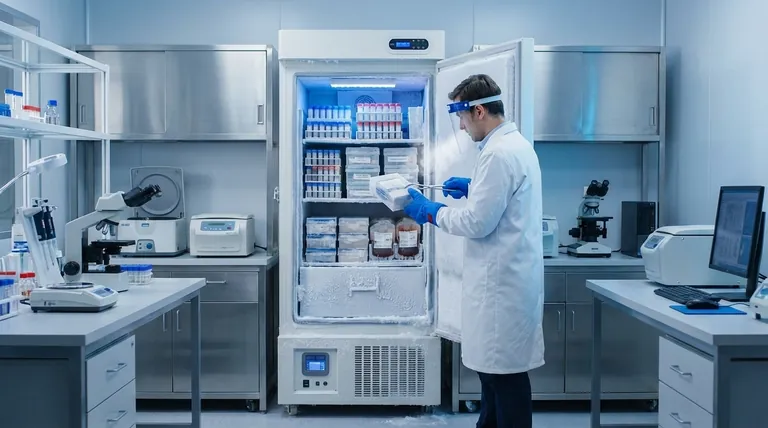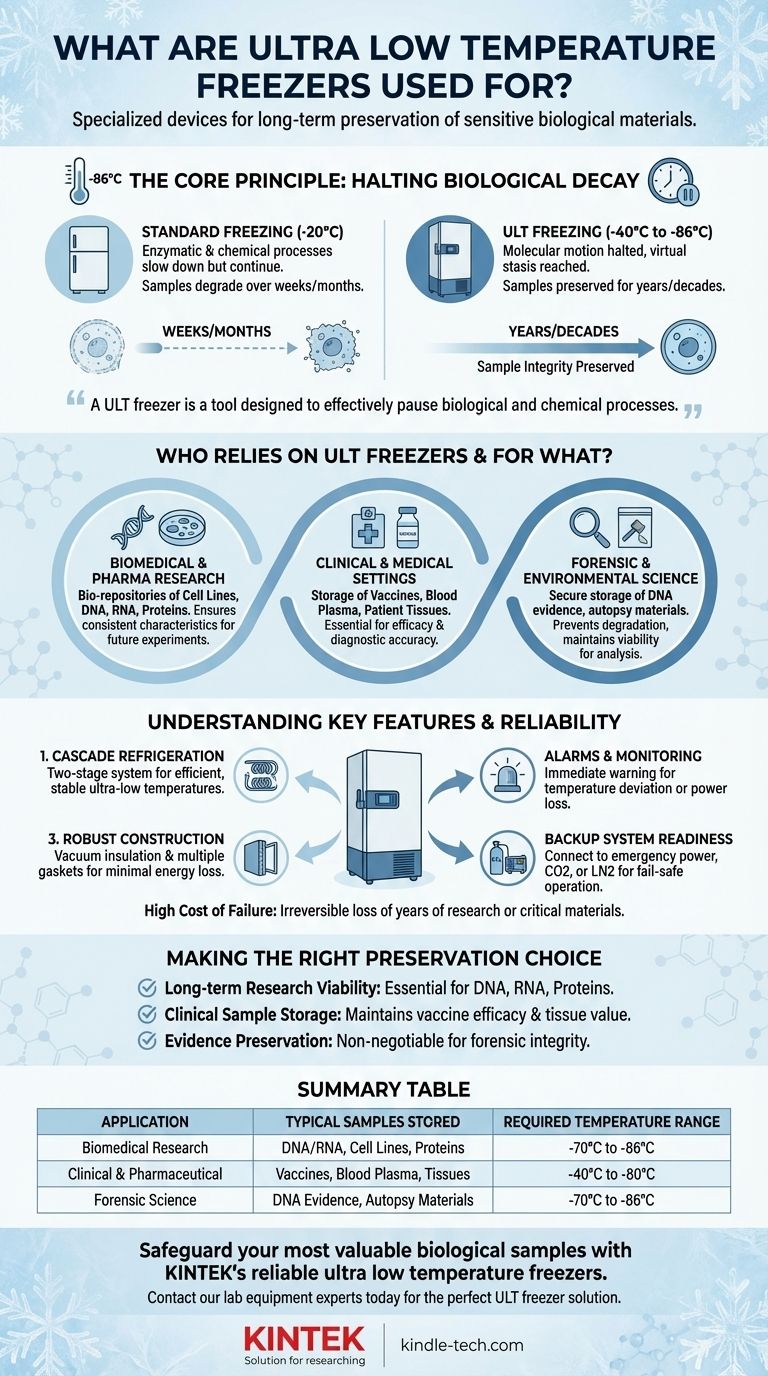In short, ultra low temperature (ULT) freezers are specialized devices used for the long-term preservation of sensitive biological materials. They provide a stable, extremely cold environment (typically below -40°C) required to store items like vaccines, DNA/RNA, cell lines, tissues, blood products, and other critical biological samples without degradation. These freezers are indispensable in biomedical research, hospitals, pharmaceutical labs, and forensic facilities.
The core challenge in storing biological material is a race against time and natural decay. A ULT freezer is not just a cold box; it is a tool designed to effectively pause biological and chemical processes, ensuring the long-term integrity and viability of irreplaceable samples.

The Core Principle: Halting Biological Decay
ULT freezers are used because standard refrigeration is insufficient for long-term preservation. The extreme cold they generate is fundamental to stopping the processes that would otherwise destroy a sample's value.
Why Standard Freezing Isn't Enough
A typical laboratory or household freezer operates around -20°C (-4°F). At this temperature, biological processes like enzymatic activity and chemical reactions are slowed, but they are not stopped.
Over weeks and months, this residual activity can degrade complex molecules like RNA, proteins, and other cellular components, rendering a sample useless for sensitive analysis or clinical use.
Reaching the Point of Stasis
ULT freezers operate at temperatures from -40°C down to -86°C (-40°F to -123°F). At this point, the molecular motion within a sample is so drastically reduced that it enters a state of virtual stasis.
This environment effectively halts enzymatic degradation and other chemical reactions. It allows delicate materials to be preserved for years, or even decades, with their molecular structure and biological potential fully intact.
Who Relies on ULT Freezers and for What?
The need to guarantee sample integrity makes ULT freezers a cornerstone technology across several critical scientific and medical fields.
In Biomedical and Pharmaceutical Research
Researchers rely on ULT freezers to create bio-repositories of cell lines, DNA, RNA, and proteins. These sample libraries are invaluable assets for studies in genetics, drug discovery, and molecular biology.
Preserving these materials in a static state ensures that experiments conducted years apart can use samples with consistent, reliable characteristics.
In Clinical and Medical Settings
Hospitals, clinics, and blood banks use ULT freezers for the storage of critical medical materials. This includes certain vaccines (most famously the Pfizer-BioNTech COVID-19 vaccine), blood plasma, and patient tissue samples for diagnostic testing.
The guaranteed stability provided by ultra-low temperatures is essential for maintaining vaccine efficacy and the diagnostic accuracy of biopsied tissues.
In Forensic and Environmental Science
For forensic labs, ULT freezers provide secure, long-term storage for biological evidence like DNA samples or autopsy materials. The ultra-low temperature prevents degradation, ensuring the evidence remains untainted and viable for analysis years after being collected.
Similarly, environmental scientists use them to preserve plant samples, insect artifacts, or water samples for future ecological and biological studies.
Understanding the Trade-offs and Key Features
While essential, operating a ULT freezer involves managing significant risks and relying on specialized technology. The primary concern is protecting the priceless value of what's inside.
The High Cost of Failure
The single greatest pitfall of using a ULT freezer is equipment failure. A mechanical breakdown or an extended power outage can lead to a rapid rise in temperature, resulting in the catastrophic and irreversible loss of years of research, clinical materials, or forensic evidence.
This risk is why ULT freezers are not simple appliances but are engineered systems built for extreme reliability.
Key Features That Ensure Reliability
The high stakes of sample storage have driven the development of several critical features designed to prevent failure and protect the contents.
- Cascade Refrigeration: Achieving temperatures below -80°C efficiently requires a two-stage system. Two independent refrigeration circuits work in tandem (a "cascade") to reliably maintain the ultra-low setpoint.
- Alarms and Monitoring: All ULT freezers are equipped with audible and visual alarms that trigger if the temperature deviates from the set range or if power is lost. This provides an immediate warning to address the problem before samples are compromised.
- Robust Construction and Insulation: These units use advanced vacuum-insulated panels and multiple gaskets to maintain temperature with minimal energy and prevent frost buildup, which can compromise the door seal.
- Backup System Readiness: Many labs connect their ULT freezers to emergency power generators. They may also employ secondary backup systems that inject liquid carbon dioxide (CO2) or liquid nitrogen (LN2) to keep the freezer cold during a power failure.
Making the Right Preservation Choice
The decision to use a ULT freezer is dictated by the required longevity and molecular stability of the samples.
- If your primary focus is long-term research viability: A ULT freezer is the only way to preserve the molecular integrity of DNA, RNA, and proteins for use in future experiments.
- If your primary focus is clinical sample storage: ULT freezers are essential for maintaining the efficacy of highly sensitive vaccines and the diagnostic value of patient tissues.
- If your primary focus is evidence preservation: The stable, ultra-low environment of a ULT freezer is non-negotiable for maintaining the integrity and admissibility of forensic materials.
Ultimately, these devices serve as silent guardians, safeguarding the very building blocks of modern biological science and medicine.
Summary Table:
| Application | Typical Samples Stored | Required Temperature Range |
|---|---|---|
| Biomedical Research | DNA/RNA, Cell Lines, Proteins | -70°C to -86°C |
| Clinical & Pharmaceutical | Vaccines, Blood Plasma, Tissues | -40°C to -80°C |
| Forensic Science | DNA Evidence, Autopsy Materials | -70°C to -86°C |
Safeguard your most valuable biological samples with KINTEK's reliable ultra low temperature freezers.
As a trusted supplier of laboratory equipment, KINTECO specializes in providing ULT freezers that offer the precise temperature control, advanced alarm systems, and robust construction needed to protect irreplaceable research, clinical, and forensic materials. Ensure the long-term integrity of your vaccines, cell lines, and DNA samples with our energy-efficient and reliable solutions.
Contact our lab equipment experts today to find the perfect ULT freezer for your specific preservation needs.
Visual Guide

Related Products
- 158L Precision Vertical Ultra Low Freezer for Laboratory Applications
- 508L Advanced Vertical Ultra Low Temperature Freezer for Critical Laboratory Storage
- 938L Vertical Ultra Low Temperature Freezer for Advanced Laboratory Storage
- 808L Precision Laboratory Vertical Ultra Low Temperature Freezer
- 408L Advanced Vertical Laboratory Ultra Low Temperature Freezer for Critical Research Material Preservation
People Also Ask
- What features do ultra-low temperature freezers typically include? Ensuring Absolute Sample Security
- What temperature range do Ultra-Low Temperature freezers maintain? The -80°C Standard for Sample Integrity
- Where are ultra low temperature freezers commonly used? Essential for Labs, Hospitals, and Biotech
- What makes Ultra-Low Temperature freezers energy efficient? Key Design & Operational Strategies
- In what fields are ultra low temperature freezers most commonly used? Essential for Biomedical, Clinical, and Research Labs



















